Software plays an increasingly vital role in conservation, helping to protect and manage biodiversity through innovative technological solutions. It also facilitates collaboration among researchers, local communities, and governments, empowering them to develop sustainable conservation strategies. However, many of us working in conservation tech don't have the benefit of a large team of software experts to collaborate with or bounce ideas off of. We aim to change that.
This group is for anyone interested in applying software to conservation and wildlife research. Whether you're a developer eager to contribute to conservation or a newbie with valuable data and ideas but limited software experience, this group connects people with diverse expertise. It provides a space for asking questions, sharing resources, and staying informed about new technologies and best practices. We are also committed to supporting technologists and conservationists from the Global South, ensuring that everyone has access to the tools, knowledge, and opportunities to contribute meaningfully.
Our goal is to foster collaboration and avoid "reinventing the wheel" by sharing solutions, whether it's an application, design approach, or a simple script. We also aim to lower barriers to entry by offering mentorship and guidance and providing feedback on technical ideas. This supportive community is a place to learn, connect, and contribute to the advancement of conservation through software. Whether you're looking for software and mobile app developers to help you with your conservation tech needs, have questions about development, are looking for resources, or would like to share your own app, software, or gaming tools, this is the group for you!
Resources
Header photo: Trevor Hebert
Group curators
Wildlife Protection Solutions (WPS)
Software Engineer in Conservation Tech



- 2 Resources
- 15 Discussions
- 10 Groups
Wildlife Protection Solutions (WPS)
Director of Technology at Wildlife Protection Solutions. Primarily focuses on leveraging machine learning and advanced data analytics to combat poaching, monitor biodiversity, and predict environmental threats.
- 0 Resources
- 1 Discussions
- 5 Groups
- 0 Resources
- 0 Discussions
- 6 Groups
- @Stelios
- | he/him
I am a Software Developer living in Berlin, Germany. Previously studied Informatics (BSc) and Data Science (MSc) in Athens, Greece.
- 0 Resources
- 0 Discussions
- 12 Groups
- @ctjack1109
- | He/Him
I am a graduate student at Purdue University developing low-cost IoT technology to measure wetland methane emissions. This, paired with my undergraduate education in Wildlife and Fisheries Resources, has me naturally drawn to advanced tech coupled with conservation issues.
- 0 Resources
- 0 Discussions
- 9 Groups
- @lvgliarose
- | she/her
Bat Conservation Trust
Research Manager at Bat Conservation Trust
- 0 Resources
- 8 Discussions
- 12 Groups
- 0 Resources
- 1 Discussions
- 6 Groups
- @jguenter
- | he/him/his
Species360 CEO - passionate about using data to care for and conserve species
- 0 Resources
- 0 Discussions
- 5 Groups
linkedin.com/in/brunilda
- 0 Resources
- 0 Discussions
- 1 Groups
- @ColleenEarthScape
- | She/her/hers
- 0 Resources
- 7 Discussions
- 7 Groups
- @kylejhorner
- | he/him
NatureCounts Engagement Coordinator for Birds Canada.
- 0 Resources
- 0 Discussions
- 3 Groups
- @Alawa
- | She/Her
Passionate wildlife and biodiversity conservationist
- 0 Resources
- 0 Discussions
- 24 Groups
- 0 Resources
- 0 Discussions
- 5 Groups
I am a a field biologist and a bat researcher interested in ecology, biodiversity, and conservation of mammals, especially Chiroptera.
- 0 Resources
- 0 Discussions
- 4 Groups
Conservation International is proud to announce the launch of the Nature Tech for Biodiversity Sector Map, developed in partnership with the Nature Tech Collective!
1 April 2025
Modern GIS is open technology, scalable, and interoperable. How do you implement it? [Header image: kepler.gl]
12 March 2025
The Conservation Technology Laboratory within the Population Sustainability department is seeking two fellows for summer 2025
5 February 2025
OPeNDAP is looking for a Senior Software Developer who is passionate about working on open source solutions for scientific data access.
5 February 2025
We look for a person with programming skills in R and/or Python.
4 February 2025
Key Conservation is seeking an experienced Software Developer to join our team.
28 January 2025
Article
SPARROW: Solar-Powered Acoustics and Remote Recording Observation Watch
18 December 2024
Develop state-of-the-art interactive ML-based tools for biodiverstiy conservation and related applications
11 December 2024
May be of interest to WILDLABS in terms of open source solutions, conservation tech, and learning about similar efforts. The founder of Open Sustainable Technology wrote this post about their work: https://...
2 December 2024
June 2025
event
November 2025
July 2024
event
June 2024
April 2024
46 Products
Recently updated products
| Description | Activity | Replies | Groups | Updated |
|---|---|---|---|---|
| No, I was never able to figure out how to send these to anyone on here. I was hoping to learn how to clear these videos up if possible! |
|
Camera Traps, Data management and processing tools, Open Source Solutions, Software Development | 2 years 4 months ago | |
| Fab - thanks Carly! |
|
Software Development | 2 years 6 months ago | |
| The open-source program Audacity can show the spectrograms and histograms and has quite a lot of other useful features, e.g. playing ultrasound calls slower, so it can be heard by... |
|
Acoustics, Citizen Science, Data management and processing tools, Open Source Solutions, Software Development | 2 years 7 months ago | |
| Thanks so much!! |
|
Acoustics, AI for Conservation, Animal Movement, Camera Traps, Community Base, Data management and processing tools, Drones, eDNA & Genomics, Emerging Tech, Open Source Solutions, Geospatial, Software Development | 2 years 7 months ago | |
| Hi there Camilo, What an interesting project! If you are looking for a lower cost, but effective tools for acoustic monitoring you might want to look into two options: ... |
|
Acoustics, AI for Conservation, Data management and processing tools, Sensors, Software Development, Latin America Community | 2 years 7 months ago | |
| Hi everyone, I'm new here! I'm a UX designer and researcher, and an animal lover. Excited to be part of Conservation Tech here at WildLabs... |
|
AI for Conservation, Human-Wildlife Conflict, Software Development, Wildlife Crime | 2 years 10 months ago | |
| @gracieermi & I are happy to announce the latest update to the Conservation Tech Directory, bringing our total resources in the... |
|
Acoustics, AI for Conservation, Animal Movement, Camera Traps, Community Base, Data management and processing tools, Drones, eDNA & Genomics, Geospatial, Software Development | 2 years 10 months ago | |
| Hi all, I'm looking for cities that aggregate envrironmental data from open sources, and potentially their own monitoring sources,... |
|
Software Development | 3 years 1 month ago | |
| Hi Dexter, In case you have not found your solution yet: I don't know of an off the shelf solution for what you need, but it seems to me that any more or less developed... |
|
Software Development | 3 years 2 months ago | |
| Biologists without Borders has developed a free mobile app (i of the Elephant) that lets the public report where ivory is being sold. We send our reports of ivory being... |
+3
|
Software Development | 3 years 6 months ago | |
| Hi community, We're looking for a mobile lead engineer to help us protect some of the world's most endangered species... |
|
Protected Area Management Tools, Software Development | 3 years 8 months ago | |
| Kobocollect could be adapted to and easy to use: https://www.kobotoolbox.org/ |
+6
|
Software Development | 3 years 8 months ago |
Creating a wifi hotspot in a remote site
17 April 2019 3:30pm
10 May 2019 7:12am
Hi Jenny,
Trust you're well. Were you successful in getting something for your team?
4 June 2019 4:02pm
Hi Jenny,
Interesting problem.
I don't have direct experience, but it looks like there are some experts you can probably reach out to and ask... if you haven't already:
http://www.groundcontrol.com/Caribbean_Satellite_Internet.htm
http://www.globaltt.com/en/internet_satellite/Caribbean.html
Also I found an interesting discussion on Reddit:
https://www.reddit.com/r/networking/comments/72wrio/satellite_internet_in_the_caribbean/
Best of luck!
Ivan
Technology lab focused on wildlife protection opens on Ol Pejeta Conservancy
31 May 2019 12:00am
Canopy height mapping with drones
31 May 2019 12:00am
Investment Showcase and Pitching Competition
24 May 2019 1:14pm
FLIR Conservation Discount Program
23 May 2019 12:00am
Announcing DotDotGoose – open source software for counting objects in an image
22 May 2019 1:37pm
GWP Webinar Recording: Using SMART at scale for effective wildlife protection
21 May 2019 12:00am
Meet the WILDLABS TECH HUB Winners
13 May 2019 12:00am
SocialCoder.org
27 March 2019 11:13am
28 March 2019 10:45am
HI Robert,
I have so many thoughts about this topic.. will try to keep them brief! It's definitely a discussion topic I'd like to throw around in the virtual meetup we have coming up in May that's going to be about Tools and Spaces for Collaboration.
I haven't seen this programme specifically, but I'm aware of others that have similar goals. I (and a lot of others) agree - better/clearer pathways for connecting tech people with conservation needs is something long overdue for conservation tech. It's a need we've had our eye on since launching WILDLABS.
We're seeing it happen organically/opportunisitcally here in WILDLABS already (sometimes exactly the way you've mentioned - people posting in forums, other times it's happening behind the scenes with our community team making the connections). But I think we've reached a maturity/stability level in the community where we can now think about how to do it more strategically.
In our 2019 survey (still a few days left to get your thoughts in - access it here), the priority we're hearing from respondants is for tools that make it easier to either find projects to get involved in, or to find people/skills who can answer needs - tools for collaboration. I've included the current responses to this question below. At the top of the list is an 'I need help portal' - I envisage this as a sort of Task Rabbit for conservation. This could be one way of delivering this matchmaking service at scale and giving tech people (early career or not) an easier way to find projects that need there specific skill set.
I think there's also a need for a more bespoke approach, that like a mentoring/hand-picked matching process. Inevitably this is way heavier on the staff capacity requirements but may have a greater impact.It feels like this might be closer to the social coder approach. The SCB Conservation Tech Working Group is working on developing a path for how we can engaging individual tech experts and connect them with projects/challenges that could use their expertise (we'll share more on this as it evolves), and the WILDLABS Tech Hub is developing this sort of approach at a company level, engaging whole teams from tech companies strategically based on specific projects needs.
One final thought - when we're talking about these sort of initaitves, I think it's important to keep in mind that while there's a clear benefit for getting tech people involved in addressing conservation needs, there is also a cost/risk especially if there isn't alignment between the skills on offer and an actual need. It can take significant staff time to manage these projects or even just articulate the challenge properly, if there isn't a plan for sustaining the solution then conservationists are left with something that ends up draining resources/not delivering, and we also run the risk of fatigue with tech projects not working out or field teams not wanting to be test subjects and just wanting things that work. These challenges are not a reason avoid this work, but they are things to keep in mind.
Anway, interested to hear your thoughts or anyone elses? Are others thinking in this space? Does what i've said resonate?
Steph
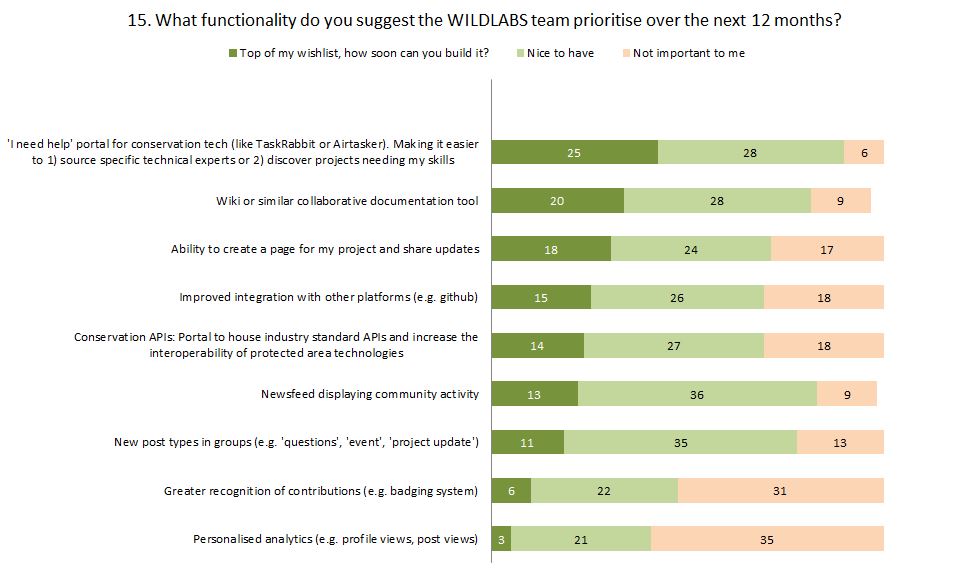
WILDLABS Virtual Meetup: Low Cost, Open-Source Solutions
18 March 2019 12:00am
Help Offered: Technology Professional (Software) Looking to Help
21 February 2019 4:18pm
Technology Professional Looking to Help
21 February 2019 4:09pm
we seek Beta-testers for our new platform for wildlife intelligence
23 January 2019 6:56am
18 February 2019 12:29pm
Excellent, that good to hear.
No, I didn't have anyone in particular in mind, it's just helpful to have that info in the back of my mind as I talk to different people/projects. I was also wondering whether to include the invite in our next Digest which will be coming out tomorrow, and based on this response I'll pop it in there :)
18 February 2019 12:45pm
Great :-)
19 February 2019 11:17pm
Congratulations! This looks like great tech.
Call for action for tech people
17 February 2019 11:22am
TRAINING Opportunity: Open spots available at first ever Global SMART Marine Training in Jamaica March 2019
14 February 2019 8:56pm
Call for ideas & feedback
2 January 2019 5:24pm
7 February 2019 12:45am
It certainly is. Whatever gets the job done and makes it easier for us to find the animals and prosecute the poachers. Also interested in thermal-imaging hardware and perhaps radar. I'm new to them all.
11 February 2019 9:57pm
Hello Sean
If you want to get hands-on with thermal imaging hardware then you may be interested to know that this type of technology has dramatically reduced in price in recent years. IR cameras used to costs thousands (€, £, $) but can now be had for around US$500. See here for the FLIR C2: https://www.flir.com/products/c2/
I bought one of these a couple of years ago for building inspections etc. I would expect it to show very clearly any captured animals as long as they are alive. Having said that, you need ideally a good difference in temperature between object of interest and surrounding area. From my time in Taiwan I would expect that for some part of the year you won't get much contrast. Worth trying anyway. This would, of course, be a rather manual solution to finding captured animals.
In theory, you would be able to pick up metal objects with this, too, even if they are at the same temperature as their surroundings. Bare metals (i.e. not covered in something like paint) have a very different "thermal signature" (technically known as "emissivity") from many other materials. This means they usually appear much cooler in a thermal image than they actually are. The reason you are unlikely to pick this up with a basic IR camera is quite simply the low resolution of such cameras. The FLIR C2 has 60x80 pixels. Much more expensive cameras are better on this point but you would still have to watch very carefully to pick up a thin wire that would only be a few pixel wide at the most.
It may be worthwhile getting in touch with FLIR directly to see what ideas they have. I would not be surprised if they have a base in Taiwan.
Good luck,
Joachim
11 February 2019 10:27pm
Hello Sean
I just had another thought: industrial machine vision systems come with all sorts of image inspection tools including such things as "edge detection". I wonder if this could be used in conjunction with a normal (not thermal) high resolution digital camera.
The general idea would be to:
1. take photos whilst on the move through a snare-infested area where a high res camera would be able to pick up a thin wire loop with sufficient resolution to make it visible;
2. let attached computer with vision software analyse images instantly for straight or looped edges that would indicate a snare.
What could help considerably is to take pictures in subdued natural light, maybe at dusk or dawn using a strong flash, possibly not just the built in flash of the camera but an external one. On the assumption that most snares are made from plain "shiny" metal, they should show up fairly well as "bright highlights" against the otherwise fairly dull (in terms of specular reflection) undergrowth. It would get more difficult though if the foilage was covered in water droplets as these would reflect the flash light, too.
I admit this is an idea that just sprung to mind and I have no idea how well this may work in practice. If you want to have a go yourself, set up a typical "snare scenario" and take some high resolution photos as described above from a few metres away. Then use free vision system software to process the images on your computer and see what you can find. Try this one, for example, https://www.teledynedalsa.com/en/products/imaging/vision-software/sherlock/
I have used it some years ago (for an industrial application) and found it very useful on early trials as it allows you to use all features processing images from a local folder rather than a live camera. This would be all you need to test whether there is any merit in this.
Sorry if industrial vision applications are not within your skill set but I thought I mention it here in case someone else wants to investigate it. I am not exactly twiddling thumbs otherwise I would be seriously tempted to have a look at this myself (pun intended:)).
Let me know if you need some more input on this,
Joachim
P.S.: A rough calculation on camera resolution:
- snare wire diameter is, say, 3 mm
- target size in image of the wire is at least 6 pixels (to reliably show diagonal edges)
- 20 Megapixel camera image is about 5000 pixel wide
- then you could cover an area 2.5 m wide per image (5000 / 6 * 3)
> this may be a workable distance to cover per image.
rOpenSci Community Call - Governance strategies for open source research software projects
10 December 2018 5:18pm
Open spots available at SMART Advanced Training in Zambia January 2019
6 December 2018 1:13pm
How to help
22 November 2018 3:52pm
27 November 2018 2:51am
Hi Ross,
Let's connect - I am a social scientist that has been researching demand reduction and am working on some projects, including a website, that helps consumers avoid illegal "unsafe" souvenirs. I have a few ideas floating around in my head that would take someone more tech-savvy than me to know if feasible - maybe we can exchange thoughts via email. I'd love to hear more about your ideas to reduce demand!) Feel free to email me at rosemarythitchens@gmail.com.
Best, Rosemary
29 November 2018 2:31pm
Hi Ross,
We are developing a web-based platform with multiple tools to analyse biodiversity quality, habitat assessement management and other apps. We need some help thinking how to monetise the apps/subscriptions as well as further developing the platform. You can email me here: vance.russell@ecosulis.co.uk if interested. Thanks.
Kind regards,
Vance
WILDLABS Virtual Meetup: Big Data in Conservation
27 November 2018 12:00am
Project BEESWAX7 Infographic
13 November 2018 2:27pm
26 November 2018 9:10am
Love it! Covers so many of my interests - conservation, beekeeping and fiddling with Arduinos - would love to know more about the project.
Live discussion on intersection of conservation and games
14 November 2018 1:22pm
23 November 2018 3:14pm
Hey Gautum,
Looks like the interview went really well! If people weren't able to make it, Gautam's interview along iwth others in the series are all available to watch here.
Steph
A technologist's journey to protect wildlife: The reality and potential of conservation technology (recorded talk)
22 November 2018 12:00am
Developer job at Octophin Digital
13 November 2018 2:50pm
Mobile App Comparison Table
14 August 2018 5:12pm
19 September 2018 6:51pm
iRecord App - is UK specific, but allows to record over 100,000 taxa.
19 September 2018 11:25pm
Some other data collection apps.
https://www.proofsafe.com.au/
https://five.epicollect.net/
19 October 2018 2:16pm
Hi Shannon, this is really useful, thanks!
Tusk Conservation Lecture 2018: Ted Schmitt
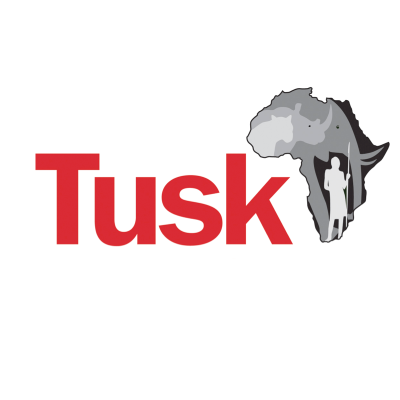 Tusk
Tusk
15 October 2018 12:00am
Looking for a front-end developer for the AI for Earth call for project
14 September 2018 2:32pm
Ocean Hack: San Francisco, 10-11th September, 2018
 One Ocean Collab
One Ocean Collab
20 August 2018 12:00am
Wildlife monitoring using Smart-Cities tech
14 June 2018 10:49am
2 August 2018 1:23pm
Hi Nilaksha!
Thanks for your comments and interest in our project. I read your project profile and would like to suggest that you take a look at using LoRaWAN for low levels of communications traffic? We are looking and testing kit for use with the www.thethingsnetwork.org It might use less power than cellular or wifi networks?
I hope this helps,
2 August 2018 1:36pm
@simulsys Thanks Andrew. Indeed we're looking into LoRa technologies.
8 August 2018 11:18am
Both initiatives are very interesting. I love the one about the elephants that @nilaksha comments.
There are currently several projects that are using artificial intelligence (in fact, Microsoft is looking for interested parties for possible funding https://www2.fundsforngos.org/environment-conservation-climate-change-and-ecology/ai-for-earth-program-seeking-proposals-from-all-over-the-world/). But its main objective is to identify the species thanks to techniques such as deep learning and I do not know if it would be applicable in the present case.
Regards,
Judit
Wildlife Crime App Development
19 August 2016 11:53pm
12 July 2018 9:45pm
Hi Rosemary,
I know this is from quite a while ago, but I'd be interested in hearing how this moved forward and connecting with you. Please feel free to reach out directly - my email is me@whistleblowers.org.
Best, Maya
7 August 2018 9:21pm
Hi Maya,
We were able to get a website developed (www.safesouvenirs.com) but are now waiting on possible grant funding. In order to move forward, we would like to some work on uploading to our database and also getting into airports to advertise. So, fingers crossed that we are successful with the grant. Either way - I think it would be great to connect. I'll follow-up with a direct email.
Best, Rosemary
8 August 2018 11:05am
Hi Rosemary,
Do you know this website that gathers grants and resources for sustainability?
https://www2.fundsforngos.org/category/environment-conservation-climate-change-and-ecology/
Regards,
Judit






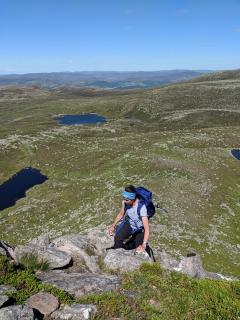

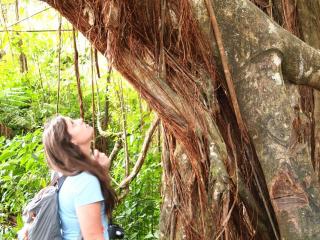





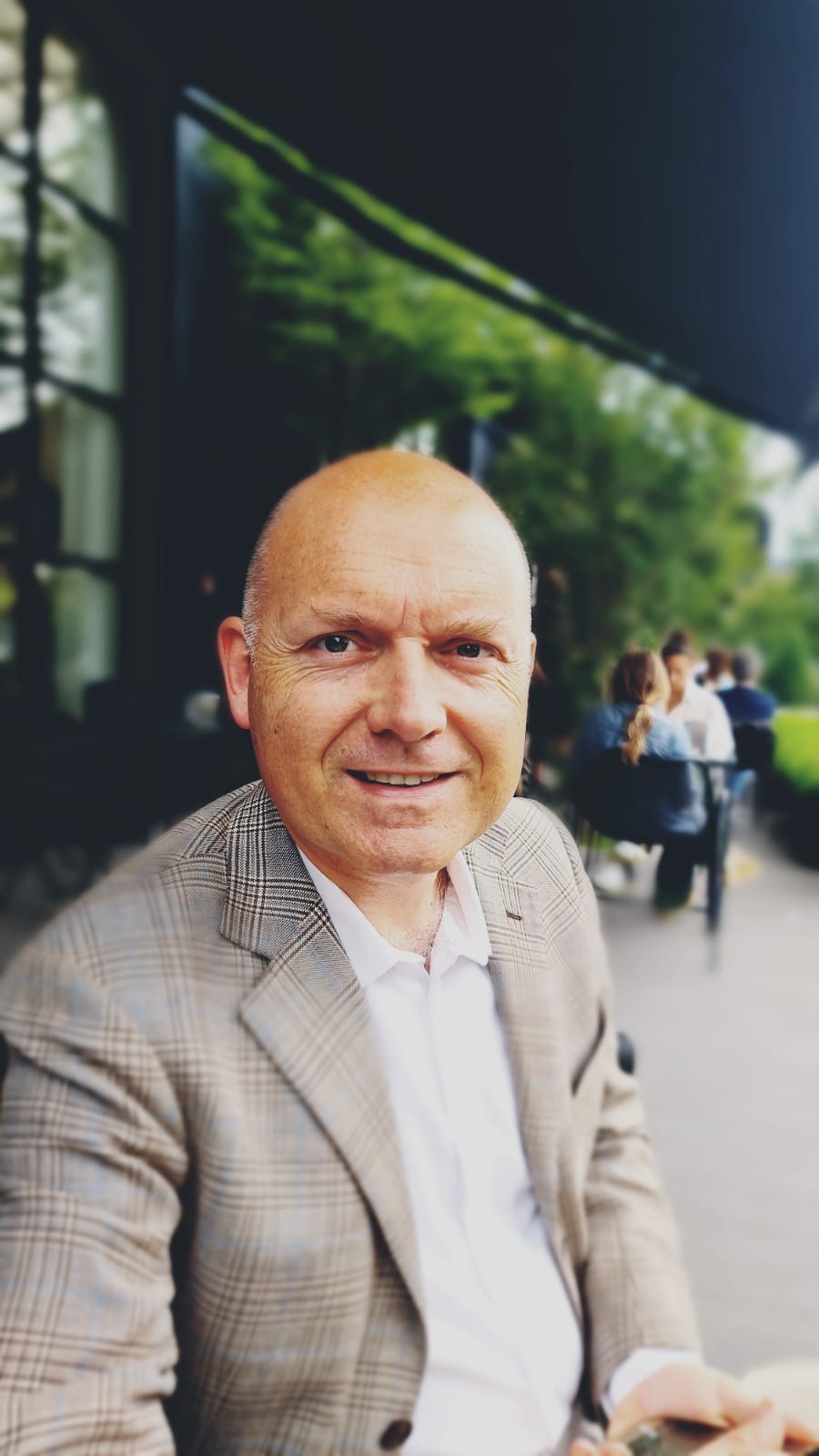




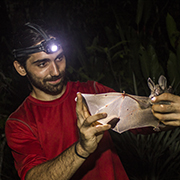




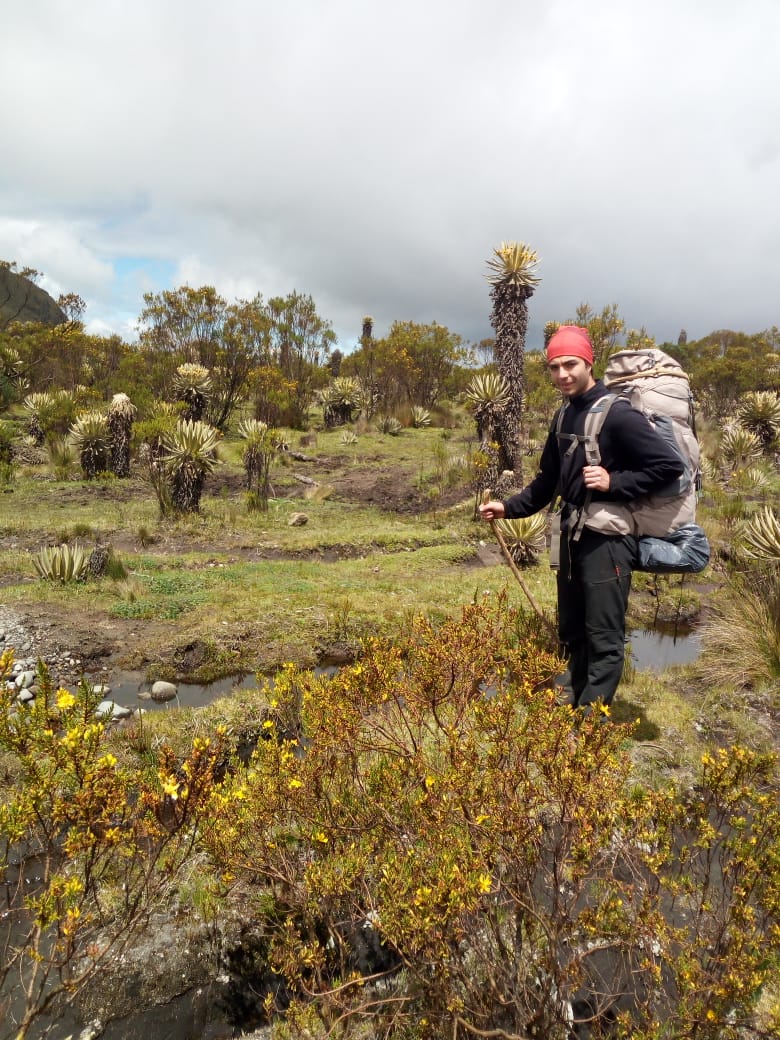







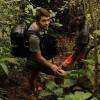

















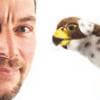




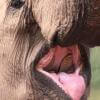










18 April 2019 10:03am
Thanks1 The Moja system looks fantastic. I've neevr heard of anything similar in the Caribbean.